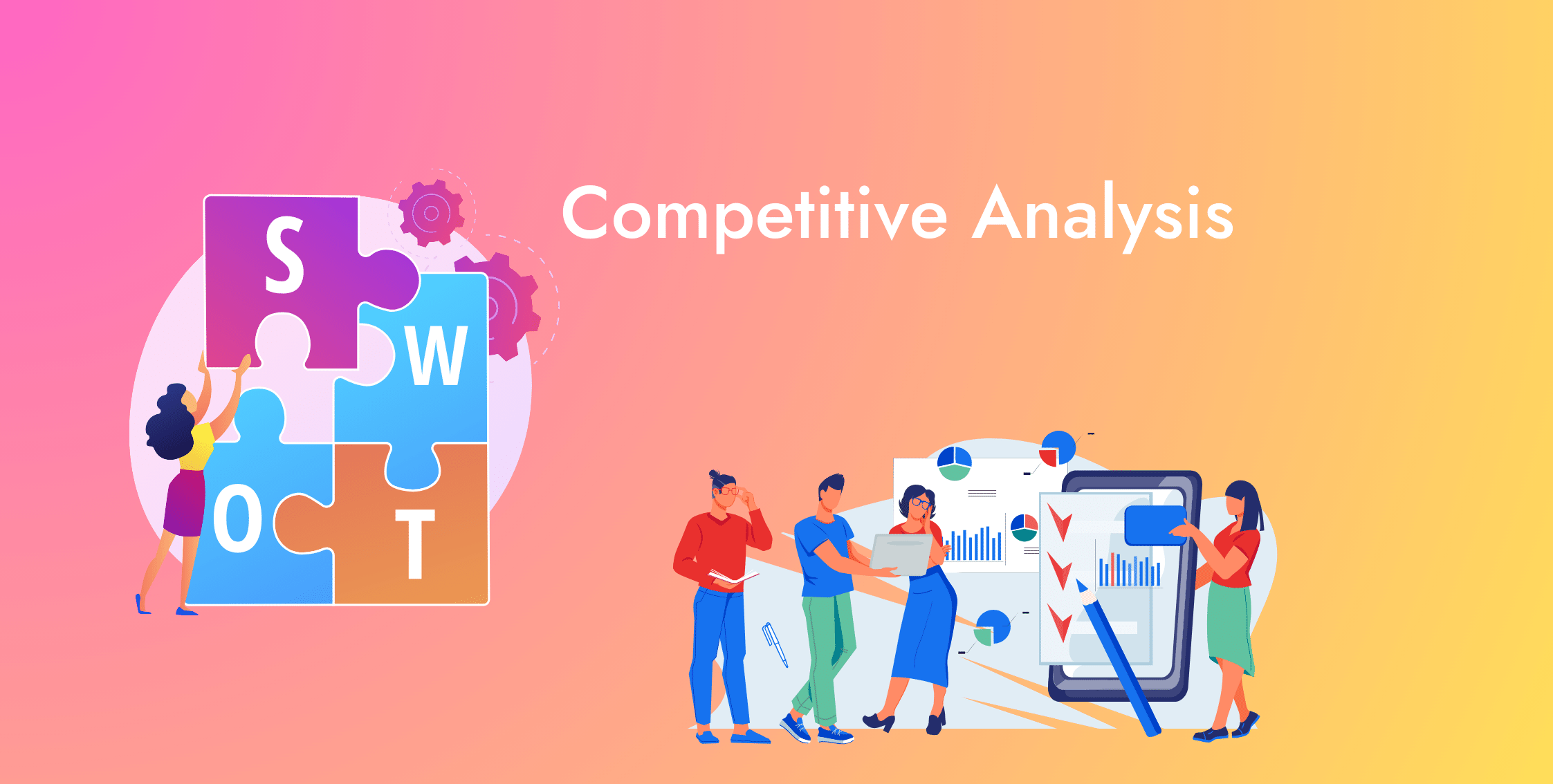In 2021, the top five online stores were responsible for 42% of the total sales of the top 500 online stores.
Competitive analysis is the only thing that could help businesses understand how their competitors outdo them and keep themselves afloat in such fierce competition.
It offers a chance to gain an in-depth understanding of their competitors' successful strategies and what they could do to replicate their model.
In this blog post, we'll delve into what competitive analysis entails and a step-by-step guide to performing a competitive analysis.
What is Competitive Analysis?
Competitive analysis, or competitor analysis, involves identifying, analyzing, and understanding your competitors and their strategies to gain a competitive advantage.
It involves systematically gathering and analyzing competitor information about their;
- Products & Services
- Pricing
- Strategies
- Strengths And Weaknesses
- Market Positioning.
Competitive analysis is a strategic process to evaluate and understand competitors within a particular industry or market segment.
It allows them to gain valuable insights into their competitive landscape, identify opportunities and threats, and formulate effective strategies to enhance their competitiveness and market position.
Let us first understand why it is important to do a competitive analysis.
Get in touch to learn about Analytico’s Digital Analytics Audit services or GA4 audit services.
The Importance of Digital Competitive Analysis
Competitive analysis offers numerous benefits to businesses aiming to thrive in a competitive marketplace.
1. Identify Market Opportunities
By analyzing competitors' strategies and performance, you can uncover emerging trends and identify gaps between competitor services and customer needs.
They can capitalize on market opportunities to offer new products or services or differentiate existing ones.
2. Understand Customer Preference
Competitive analysis helps businesses gain insights into customer preferences, behaviors, and pain points through deep analysis of the competitor's product, pricing, and customer feedback.
It enables businesses to tailor their products or services to enhance their capacity to meet customer needs.
3. Improving Marketing Effectiveness
Analyzing competitor strategies and tactics allows businesses to identify what works and what does not work for their audiences/customers.
They could learn from their success stories and failures to optimize their marketing efforts, ad spend, innovative techniques, and refined messaging to outdo their competitors and better resonate with target audiences.
4. Benchmark Performance
Comparing key performance indicators (KPIs) such as sales, market share, profitability, and customer satisfaction against competitors allows businesses to create benchmarks.
They can then use these performance benchmarks to evaluate their performance and identify areas for improvement.
5. Inform Strategic Decision Making
Insights from competitive analysis can help businesses make more informed strategic decisions.
These decisions could involve adjusting prices, refining products, expanding into new markets, or allocating budgets for marketing campaigns.
6. Mitigate Risks
Monitoring competitor actions and analyzing market trends allows businesses to identify potential threats and risks proactively.
Some examples of such threats and risks include new competitors entering the market, changing consumer preferences, or disruptive technologies.
They could use this opportunity to develop contingency plans and mitigate these risks.
7. Enhance Competitive Advantage
Understanding competitors' strengths and weaknesses allows businesses to leverage their unique capabilities and resources to stand out in the marketplace.
It gives a competitive edge over their competitors, enhancing their chances of increasing their return on investment (ROI).
Overall, competitive analysis is a strategic tool that empowers businesses to stay agile, innovative, and competitive in an ever-evolving marketplace.
The goal is to use it to ultimately drive growth, profitability, and long-term success.
How to Conduct Digital Competitive Analysis?
1. Identify Competitors
A great way to start identifying your competitors is to outline your goals, brand, products & services. Use that information as a baseline to identify your competitors.
Find them by pulling in your internal knowledge, information from reviews and reports, and thorough internet research.
Begin by looking for businesses within your industry or niche that offer similar products or services and compete for the same target audience.
These are your direct competitors.
Another group you need to consider is your indirect competitors. They may offer different products or services than yourself, but share your target audience.
This latter group is not your main focus but rather one you keep an eye out for to ensure you can identify emerging players and disruptive entrants within your industry.
2. Gather Data
It is time to gather data about your competitors to tell a story about their success and marketing strategies.
Collect data about your competitors’ organizational structure, management, business models, history, and possible mergers or acquisitions.
Your data of interest also include their job openings, areas they are expanding into, marketing strategies, customer size, and revenue earned.
These pieces of information allow you to estimate their growth potential, capacity for gaining market share, and loyalty.
Here are some resources for gathering data about your competitors.
- Company website
- LinkedIn and Social Media
- Public Customer Feedback
- Financial Reports (for publicly traded companies)
- Analytics Tools - Similarweb (paid/unpaid traffic), Google Trends
- SEO Tools - Ahref, Semrush
- Marketing Intelligence Tools - Wappanalyzer, Compete Shark.
3. Analyze Data
Now that you have all the background information about your company, customer size, and estimated revenue, it is time to perform data analytics.
You must have all the collected information neatly organized and ready for analysis. Arrange it on a grid to collect all the relevant information and better comparison.
Analyze their data to find values, trends and patterns, strengths and weaknesses, and opportunities.
You can later use this information against your analytics to identify where you stand compared to your competitors.
4. Evaluate Your Competitors
Now that you have the numbers and patterns from your data analysis, you could use this information to evaluate your competitors and get insights.
This analysis helps in identifying areas of differentiation and potential competitive advantages.
I) Competitor Value Proposition
The value proposition is a statement where a business declares how they help their customers, mentioning the pain point, the solution they offer, and how it benefits the customers.
Use the results from data analysis to evaluate your competitor’s value proposition. Evaluate it against actual data and any facts and figures they back it up with.
Compare the quality of their product or service, pricing models, and how much they deliver on their promises.
It tells you what sets your competitors apart, convincing the customers to pick their product or service over others.
II) Competitor Marketing Efforts
Next, evaluate your competitor’s marketing efforts if the value proposition tells you what they offer and why customers may pick them.
Evaluating their marketing efforts tells you how they communicate their unique offerings to customers.
Review the following for evaluating your competitors’ marketing efforts.
- Content (Blogs, Videos, Reports)
- Ad Copies
- Marketing Channels
- Paid Advertisements
- Social Media (influencer marketing if applicable).
III) Competitor Brand Identities
Finally, evaluate your competitor’s brand identities to assess why customers are connected to and show loyalty to their brand.
Evaluate brand aspects such as
- Logo /visuals/style.
- Content, messaging.
- Communication.
Also, you want to know what emotions these features of your competitor’s brand identity invoke in them.
5. Evaluate Competitor's Target Customer
Next, evaluate your competitor’s target customers to understand who they are, their needs, and preferences.
It will enable you to find opportunities to position yourself better in the market.
Begin by profiling the competitor’s target customers to understand them and look for information like5.
- Location.
- Demographic
- Interests
- Preferences
- Behaviors
Map their entire customer journey and identify the critical touchpoints. You could exploit this information to your advantage.
Next, spy to find how the target customers engage with your competitor. Look at their social media reviews, comments, and responses to email marketing to assess customer satisfaction and loyalty.
These are all valuable factors in understanding their decision-making and choosing your competitor’s product or service.
It also offers opportunities to identify possible dissatisfaction or product or service gaps.
Regardless, you may use this information for product or service differentiation, better communication, and the ability to position yourself in the market.
6. Analyze Strengths and Weaknesses
Finally, you have the data and the evaluations, and it is time to analyze the strengths and weaknesses of your competitors and your own.
A SWOT analysis, short for strength, weakness, opportunities, and success, allows you to understand their advantage over you.
Identify the strengths and weaknesses of your competitors
- Marketing
- Branding
- Customer Journey
- Customer Service
- Products or Services
Run a similar SWOT analysis for your business as well.
It enables you to identify opportunities. There will be two types of opportunities here. One emerges from assessing the competitor’s customer touchpoints or service gaps.
You want to capitalize on this category to gain more market share.
The second set of opportunities emerges from your SWOT analysis, where you find room for improvement.
Finally, there are threats.
These could be disruptive technologies or approaches your competitors use that you still need to be involved in your workflow and threaten your future market share.
Or include some new entrants in the market or an external factor that you could prepare for in advance to minimize its effects.
7. Insights
Congratulations on completing the competitive analysis.
It is time to compile your analyses and findings and draw actionable insights to inform your digital strategy.
Identify areas where you can capitalize on competitors' weaknesses or emulate their successful tactics while differentiating your brand.
Remember, competitive analysis is an ongoing process. Continuously monitor your competitors' digital activities and adjust your strategies to stay ahead of the curve.
Conclusion
This blog discusses competitive analysis, its importance, and how to conduct it.
Competitive analysis is thoroughly analyzing your competitors to gain a competitive edge.
The importance of competitive analysis lies in identifying opportunities, understanding customer preferences, improving marketing effectiveness and competitive advantage, mitigating risks, and informing decision-making.
To perform a competitive analysis, you need to identify your competitors, gather their data, and analyze it.
Use it to evaluate your competitors for their brand, marketing strategies, quality of their products and services, strength of their marketing strategies, and value proposition.
Evaluate your competitor’s target customers to identify their demographics, preferences, social media engagement, sentiments, customer journey, and brand loyalty.
Use these sets of information to conduct a SWOT analysis of your business and your competitors.
Finally, compile your results and draw insights to copy their success formula while differentiating your products and services to stay ahead of the curve in a dynamic marketplace.
Like what you read? Learn more on our blog here.


